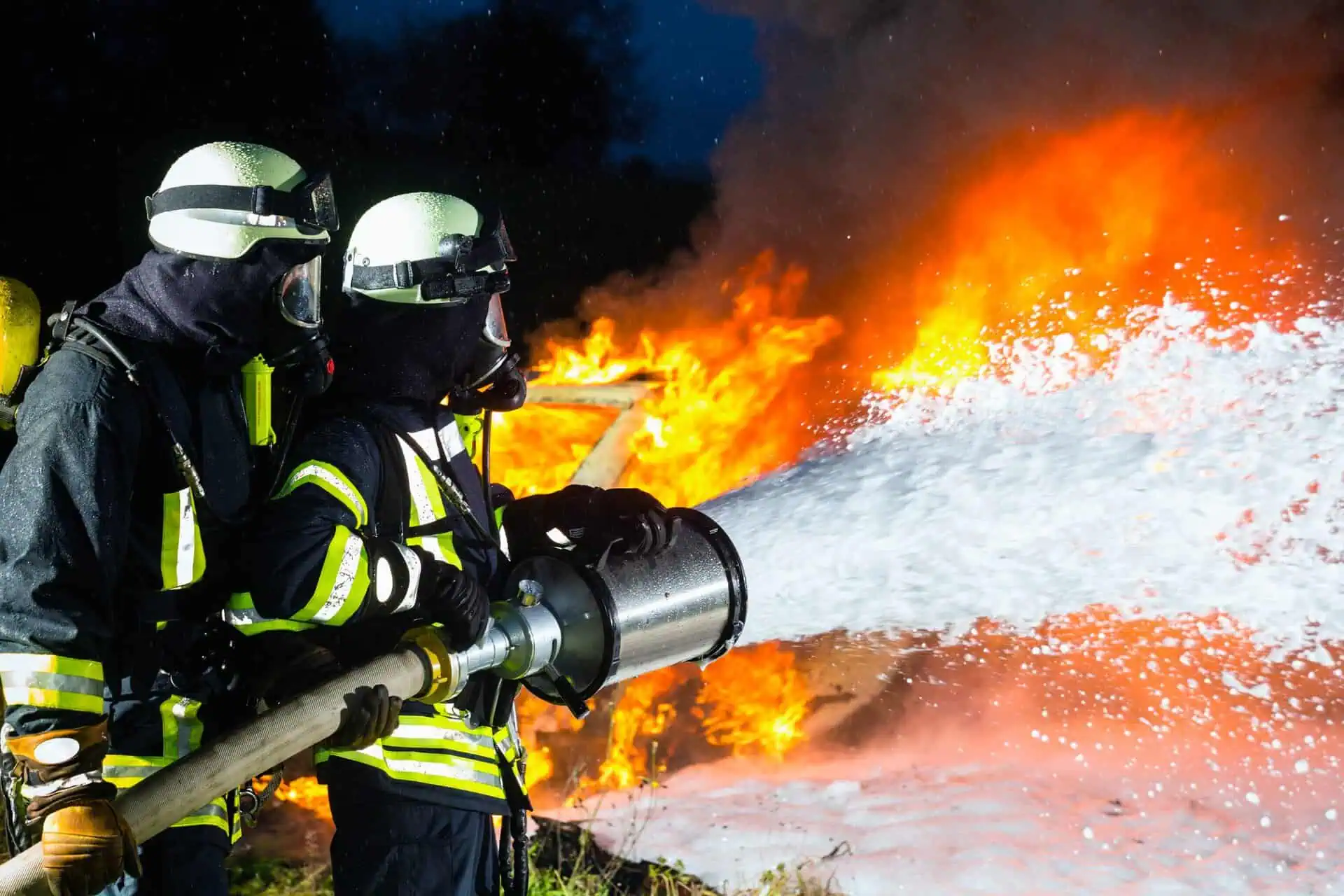AFFF Colorectal Cancer Lawsuit
- Last Updated: June 12th, 2025

Attorney Jessica Paluch-Hoerman, founder of TruLaw, has over 28 years of experience as a personal injury and mass tort attorney, and previously worked as an international tax attorney at Deloitte. Jessie collaborates with attorneys nationwide — enabling her to share reliable, up-to-date legal information with our readers.
Legally Reviewed
This article has been written and reviewed for legal accuracy and clarity by the team of writers and legal experts at TruLaw and is as accurate as possible. This content should not be taken as legal advice from an attorney. If you would like to learn more about our owner and experienced injury lawyer, Jessie Paluch, you can do so here.
Fact-Checked
TruLaw does everything possible to make sure the information in this article is up to date and accurate. If you need specific legal advice about your case, contact us by using the chat on the bottom of this page. This article should not be taken as advice from an attorney.
Key takeaways:
- Firefighters and military personnel exposed to AFFF, a toxic firefighting foam containing PFAS chemicals, face an increased risk of developing colorectal cancer.
- Legal battles are being waged against AFFF manufacturers as victims seek justice and financial compensation for their medical expenses and suffering due to exposure.
- Experienced firefighting foam lawyers guide affected individuals through filing claims, documenting evidence, and negotiating settlements.
Overview of the AFFF Colorectal Cancer Lawsuit
On this page, we’ll discuss an overview of the AFFF Colorectal Cancer Lawsuit, potential AFFF lawsuit settlement amounts, who qualifies to file an AFFF lawsuit, and much more.
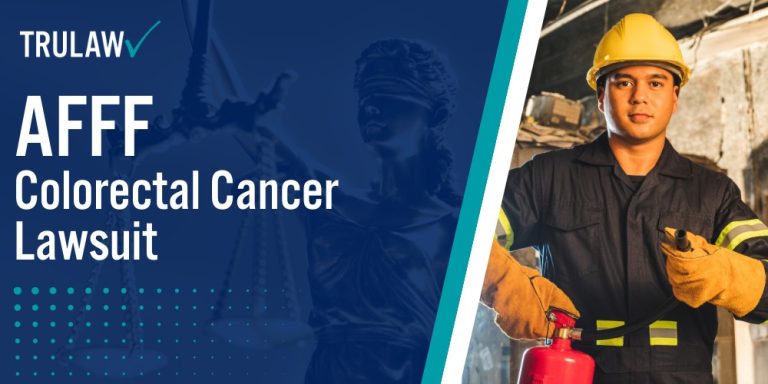
Intro to the AFFF Colorectal Cancer Lawsuits
Aqueous Film Forming Foam (AFFF) has been widely used since the 1960s in industries requiring a reliable method to extinguish fires fueled by liquids or gases.
Many firefighting foams, including AFFF, contain PFAS chemicals — often referred to as “forever chemicals” due to their persistence in the environment.
These chemicals have been linked to various cancers, including colorectal cancer, liver cancer, and other serious health risks.
Across the country, individuals exposed to AFFF are filing AFFF firefighting foam lawsuits after developing cancer or other serious health conditions potentially related to this exposure.
If you or a loved one has been diagnosed with colorectal cancer, colon cancer, or another related health issue following AFFF exposure, you may be eligible to file an AFFF lawsuit.
You can use the chatbot on this page to instantly check if you qualify to file an AFFF lawsuit.
Our team is available to answer any questions you may have about your potential claim.
If you suspect that AFFF exposure has affected your health, reach out to learn more about how we can help guide you through this process.
Table of Contents
Link Between AFFF Exposure and Colorectal Cancer
Exposure to AFFF and PFAS chemicals has been associated with an increased risk of cancer, including colorectal cancer, along with other serious health concerns.
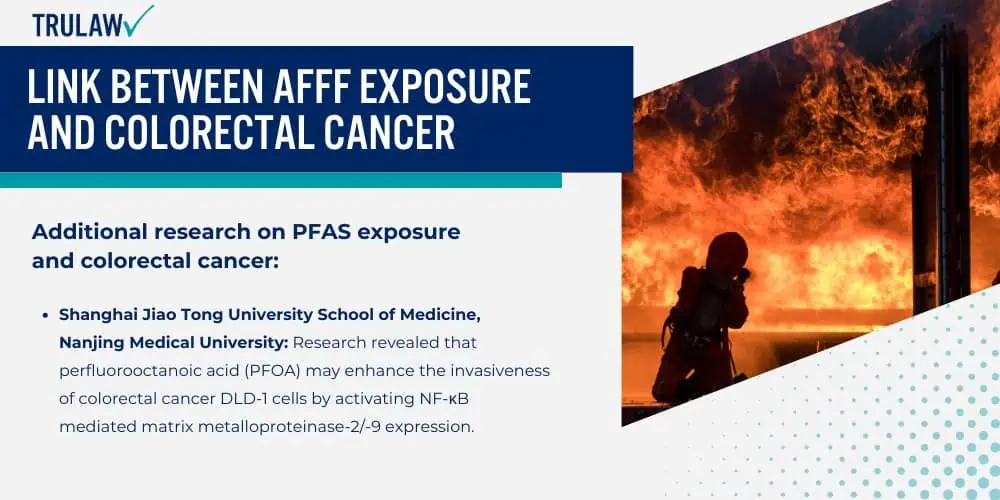
These connections have been documented in various studies by prominent organizations, such as the National Cancer Institute and the Environmental Protection Agency.
Specifically, PFAS chemicals like perfluorooctanoate (PFOA) and perfluorooctane sulfonate (PFOS) have been linked to a higher likelihood of developing colorectal cancer.
Research indicates that these substances may contribute to an elevated risk for this type of cancer.
A study conducted by researchers at West Virginia University examined colorectal cancer (CRC) rates in people from Appalachia who were exposed to PFAS.
The study identified:
“…a strong, inverse association between PFOS and the likelihood of CRC diagnosis, along with a more modest inverse association between PFOA and CRC.”
Additional research on PFAS exposure and colorectal cancer:
- Shanghai Jiao Tong University School of Medicine, Nanjing Medical University: Research revealed that perfluorooctanoic acid (PFOA) may enhance the invasiveness of colorectal cancer DLD-1 cells by activating NF-κB mediated matrix metalloproteinase-2/-9 expression.
- University of New Hampshire, Georgetown University: A study focused on cancer risk in communities exposed to PFAS found connections between PFAS exposure and various cancers, including colorectal cancer.
Ongoing Research on PFAS Chemicals and Their Cancer Risks
Further studies have shown a concerning association between certain PFAS chemicals, like PFOA and PFOS, and the risk of cancer:
- A separate study in the International Journal of Cancer found a positive correlation between PFOS exposure and an increased risk of breast cancer.
- The International Agency for Research on Cancer (IARC) has classified PFOA as carcinogenic to humans (Group 1) and classified PFOS as possibly carcinogenic to humans (Group 2B).
- The Journal of the American Medical Association published a study finding a statistically link between PFOA exposure and kidney cancer, testicular cancer, and ulcerative colitis.
- The U.S. Environmental Protection Agency (EPA) has issued a health advisory, warning that long-term exposure to PFOA and PFOS above certain levels could harm human health. As a result, in 2024, the EPA announced the National Primary Drinking Water Regulation (NPDWR) for six (6) PFAS chemicals — establishing legally enforceable Maximum Contaminant Levels (MCLs) that water systems must test and confirm are met before distributing drinking water to the public.
The growing body of evidence linking PFAS exposure to cancer is alarming, highlighting the need for continued research to fully understand the long-term health impacts of these chemicals.
Firefighting Foam Cancer Lawsuits
Firefighting foam manufacturers are currently facing lawsuits over the presence of toxic chemicals in AFFF products, which have been linked to cancer and other serious health issues.
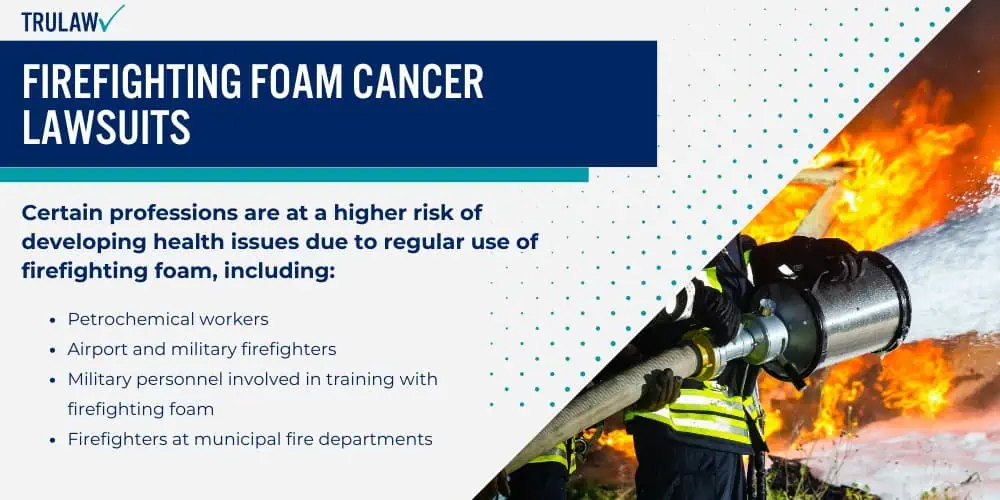
Many of these foams contain PFAS chemicals, often referred to as “forever chemicals,” due to their persistence in both the human body and the environment.
Both the Centers for Disease Control and Prevention (CDC) and the Environmental Protection Agency (EPA) have issued warnings about the health risks associated with PFAS exposure, noting that these chemicals can contribute to various medical conditions, including certain cancers.
Because PFAS do not break down over time, they remain in the body and environment indefinitely.
This exposure has been associated with an increased risk of developing cancers such as bladder cancer, prostate cancer, testicular cancer, kidney cancer, and other health problems.
Certain professions are at a higher risk of developing health issues due to regular use of firefighting foam, including:
- Petrochemical workers
- Airport and military firefighters
- Military personnel involved in training with firefighting foam
- Firefighters at municipal fire departments
- Other industrial workers
Companies facing AFFF lawsuits include:
- ChemDesign Inc
- DuPont
- 3M
- Chemours
- Tyco Fire Products
- Chemguard Inc
- Over a dozen other companies
Latest Updates on Firefighting Foam Lawsuits
AFFF firefighting foam cases are currently being managed through multidistrict litigation, with over 4,000 individual AFFF lawsuits pending.
While manufacturers have made several attempts to dismiss these claims, the legal process is continuing — our team remains committed to pursuing these cases for those affected by AFFF firefighting foam exposure.
If you or a loved one have been affected by PFAS chemicals in firefighting foam, you can explore your legal options by using the chatbot on this page to determine eligibility for an AFFF lawsuit.
Settlement Amounts in Firefighting Foam Lawsuits
It is still too early to accurately predict what the average settlement amounts for AFFF lawsuits will be.
However, based on previous cases involving PFAS contamination, settlements could range between $20,000 and $600,000 (or more).
These are only rough estimates drawn from similar cases and should not be considered a guarantee of compensation in the AFFF lawsuit.
As the litigation moves forward, we will gain more clarity on potential settlement outcomes.
Groundwater and Drinking Water Contamination from Toxic Firefighting Foam
AFFF firefighting foam has had a major environmental impact, contributing to PFAS contamination in drinking water.
The Department of Ecology from the State of Washington recently stated that AFFF is not only a major cause of PFAS contamination in drinking water — AFFF is the leading cause of PFAS contamination in drinking water.
These chemicals are highly soluble in water, meaning they can easily spread into groundwater, drinking water sources, and other natural areas.
Large quantities of foam are often used to control dangerous fires, but this leads to further contamination in the surrounding environment.
State governments, municipalities, and local water authorities have filed lawsuits over environmental contamination caused by AFFF.
Some of the entities that have joined the litigation include:
- State of New Hampshire
- State of Ohio
- State of Michigan
- State of Vermont
- City of Philadelphia, Pennsylvania
- City of Birmingham, Alabama
- City of Thornton, Colorado
- City of Baltimore, Maryland
- City of Pittsboro, North Carolina
- City of Fairbanks, Alaska
- City of La Crosse, Wisconsin
- City of Peshtigo, Wisconsin
- The Water Replenishment District of Southern California
- The Commonwealth of Massachusetts
- Various additional cities and local water agencies
Many other cities and local water authorities are also pursuing claims against AFFF manufacturers.
It’s important to note that TruLaw is only accepting clients with AFFF personal injury claims — we are not accepting clients for the AFFF municipal water contamination lawsuits.
How to File an AFFF Colorectal Cancer Lawsuit
If you or a loved one have been exposed to PFAS from AFFF firefighting foam and have since been diagnosed with colorectal cancer, other cancers, or related medical issues, you may be eligible to seek compensation through an AFFF lawsuit.
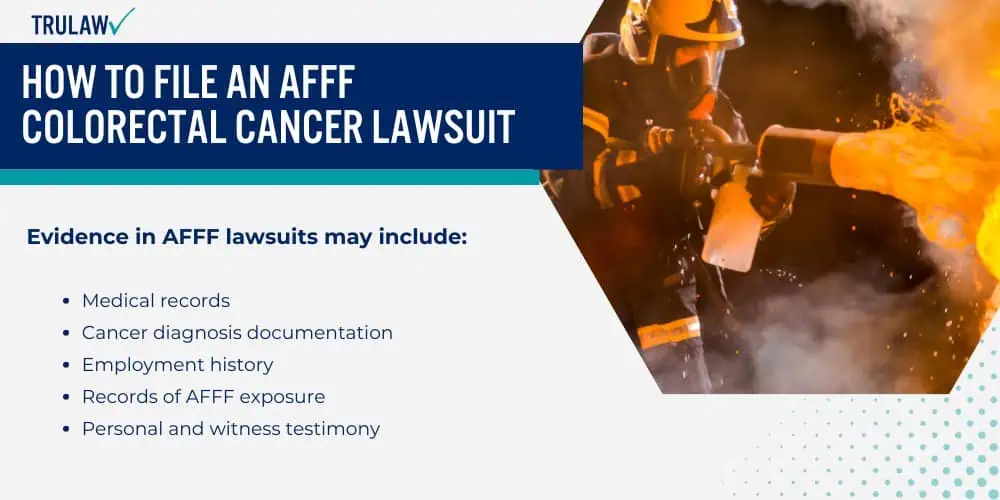
Reach out to TruLaw for a free consultation by using the chatbot on this page to instantly check your eligibility for filing an AFFF lawsuit.
Collecting Evidence for AFFF Lawsuits
Collecting strong evidence can help substantially when building a successful AFFF lawsuit.
Evidence in AFFF lawsuits may include:
- Medical records
- Cancer diagnosis documentation
- Employment history
- Records of AFFF exposure
- Personal and witness testimony
- Other relevant proof of exposure to firefighting foam
Compensation for Damages in Firefighting Foam Lawsuits
Assessing damages in firefighting foam lawsuits is a key part of the legal process.
Damages encompass both the financial and emotional losses you have endured as a result of AFFF exposure.
TruLaw is here to help evaluate the full extent of your damages and seek compensation from those responsible.
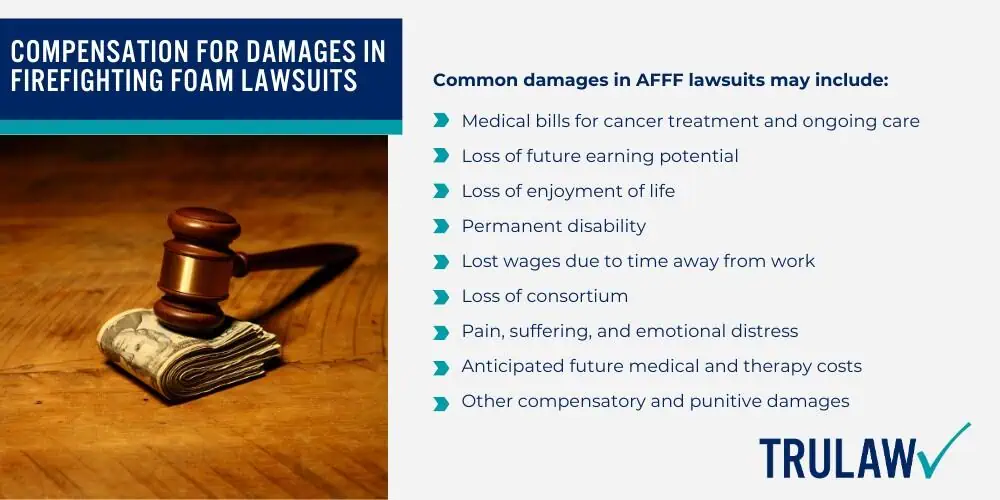
Common damages in AFFF lawsuits may include:
- Medical bills for cancer treatment and ongoing care
- Loss of future earning potential
- Loss of enjoyment of life
- Permanent disability
- Lost wages due to time away from work
- Loss of consortium
- Pain, suffering, and emotional distress
- Anticipated future medical and therapy costs
- Other compensatory and punitive damages
Importance of Hiring Experienced Firefighting Foam Attorneys for Your Claim
It’s important to work with an attorney experienced in toxic chemical exposure cases to discuss the specifics of your AFFF claim.
The AFFF firefighting foam lawyers at TruLaw and our partner law firms will work diligently to build a strong case on your behalf.
Our focus is on ensuring you receive the legal support and resources you need during this challenging time.
The legal team you choose should be committed to pursuing the compensation you deserve and supporting you every step of the way.
It’s important to carefully consider your choice of attorney when seeking justice for AFFF exposure.
TruLaw: Your Firefighting Foam Cancer Law Firm
The firefighting foam cancer lawyers at TruLaw and our partner law firms have extensive experience pursuing justice for individuals affected by harmful chemical exposures.
We aim to assist those impacted by Aqueous Film-Forming Foam (AFFF) in seeking the compensation they deserve and are are committed to holding corporations and manufacturers accountable for the health risks posed by AFFF exposure.
If you or a loved one have developed cancer or other serious health conditions after frequent exposure to firefighting foam, you may qualify to file an AFFF Cancer Lawsuit and pursue compensation for the damages you’ve endured.
Reach out to TruLaw today for more information by using the chatbot on this page to instantly determine your eligibility for filing an AFFF lawsuit.
AFFF Lawsuit Frequently Asked Questions
-
PFAS (Per- and Polyfluoroalkyl Substances) are a family of synthetic chemicals widely used in various industries due to their resistance to heat, water, oil, and stains.
These unique properties have led to their presence in many everyday products, including firefighting foam.
PFAS chemicals do not break down easily in the environment, and they can accumulate in the human body over time, potentially causing serious health issues.
Studies have linked PFAS exposure to cancer, birth defects, and other harmful effects.
As awareness of their risks grows, PFAS chemicals are increasingly being banned in many states and countries.
-
Aqueous Film Forming Foam (AFFF) is a firefighting foam used to suppress fires, particularly those involving flammable liquids such as jet fuel or petroleum.
AFFF works by creating a barrier between the fuel and oxygen, effectively smothering the fire.
Since the 1960s, AFFF has been used in industries like aviation, military operations, and petrochemical sectors to combat dangerous fires.
Several manufacturers, including 3M, Chemguard, and Tyco Fire Products, have produced AFFF and distributed it globally.
-
PFAS chemicals are found in a wide range of consumer and industrial products beyond firefighting foam.
Some of the most common products containing PFAS include:
- Cleaning products
- Water-resistant fabrics (rain jackets, umbrellas, tents)
- Grease-resistant paper
- Nonstick cookware
- Personal care items (shampoo, dental floss, nail polish, makeup)
- Stain-resistant coatings on carpets and upholstery
- Plastic wrappers and packaging (e.g., microwave popcorn bags)
- Plastic bottles
-
People at higher risk for PFAS exposure from firefighting foam are those who have worked with or around the foam in their professional duties.
Exposure can also occur through contaminated drinking water in areas near industrial sites or military bases where AFFF has been used.
Occupational exposure is most common among:
- Airport and military firefighters
- Municipal firefighters
- Industrial workers in oil refineries and similar facilities
- Workers on flight decks
- Employees at AFFF manufacturing companies
- Workers transporting AFFF firefighting foam
- Employees at incinerators disposing of firefighting foam
-
Exposure to PFAS chemicals in AFFF firefighting foam has been linked to a variety of health issues — spanning from cancer to other serious health complications.
Bladder Cancer, Prostate Cancer, & Various Other Cancers
Types of cancer linked to exposure to these PFAS chemicals include, but are not limited to:
- Bladder cancer
- Breast cancer
- Colorectal cancer
- Endometrial cancer
- Kidney cancer
- Leukemia
- Liver cancer
- Lymphoma
- Mesothelioma
- Multiple Myeloma
- Non-Hodgkin Lymphoma
- Ovarian cancer
- Pancreatic cancer
- Prostate cancer
- Testicular cancer
- Thyroid cancer
Other Health Issues Linked to AFFF firefighting foam exposure
Other types of health issues linked to exposure to these toxic chemicals include, but are not limited to:
- Thyroid disease
- Ulcerative Colitis
- Birth defects
- Heart disease
- Hormonal imbalances
- Immune system disorders
- Liver damage
- Neuroendocrine tumors
These health risks highlight the serious concerns surrounding exposure to AFFF firefighting foam.
-
AFFF lawsuits target the companies responsible for manufacturing and supplying firefighting foam to various entities, including fire departments, military bases, and airports.
Defendants named in these lawsuits include:
- 3M
- DuPont
- Chemours
- Tyco Fire Products
- Chemguard Inc.
- ChemDesign Inc.
- Numerous other manufacturers and suppliers
-
The AFFF MDL (multidistrict litigation) has been established in the US District Court for the District of South Carolina.
MDL is a federal legal procedure designed to streamline the legal process by consolidating cases with similar claims for pretrial processes.
In the AFFF firefighting foam MDL, individual lawsuits filed by people affected by firefighting foam exposure are combined to address common issues in one court.
This helps expedite the legal process while maintaining each plaintiff’s unique case.
-
The experienced firefighting foam attorneys at TruLaw and our partner law firms can guide you through every step of your AFFF firefighting foam lawsuit.
We will assist in:
- Gathering the necessary evidence for your AFFF claim.
- Evaluating the damages and costs associated with your exposure to firefighting foam.
- Identifying the responsible parties for your cancer diagnosis or health condition.
- Providing guidance through the legal process and answering any questions you may have.
- Working to secure a settlement in your AFFF cancer lawsuit.
-
The firefighting foam attorneys at TruLaw and our partner law firms work on a contingency fee basis, meaning you won’t pay any upfront fees for legal representation.
You will only be charged if your case results in a successful settlement or verdict.
If no settlement is awarded, you won’t owe any legal fees, ensuring there’s no financial risk to you upfront in pursuing your AFFF lawsuit.

Managing Attorney & Owner
With over 25 years of legal experience, Jessica Paluch-Hoerman is an Illinois lawyer, a CPA, and a mother of three. She spent the first decade of her career working as an international tax attorney at Deloitte.
In 2009, Jessie co-founded her own law firm with her husband – which has scaled to over 30 employees since its conception.
In 2016, Jessie founded TruLaw, which allows her to collaborate with attorneys and legal experts across the United States on a daily basis. This hypervaluable network of experts is what enables her to share the most reliable, accurate, and up-to-date legal information with our readers!
Additional AFFF Lawsuit resources on our website:
Here, at TruLaw, we’re committed to helping victims get the justice they deserve.
Alongside our partner law firms, we have successfully collected over $3 Billion in verdicts and settlements on behalf of injured individuals.
Would you like our help?
At TruLaw, we fiercely combat corporations that endanger individuals’ well-being. If you’ve suffered injuries and believe these well-funded entities should be held accountable, we’re here for you.
With TruLaw, you gain access to successful and seasoned lawyers who maximize your chances of success. Our lawyers invest in you—they do not receive a dime until your lawsuit reaches a successful resolution!
AFFF Lawsuit claims are being filed against manufacturers of aqueous film-forming foam (AFFF), commonly used in firefighting.
Claims allege that companies such as 3M, DuPont, and Tyco Fire Products failed to adequately warn users about the potential dangers of AFFF exposure — including increased risks of various cancers and diseases.
Depo Provera Lawsuit claims are being filed by individuals who allege they developed meningioma (a type of brain tumor) after receiving Depo-Provera birth control injections.
A 2024 study found that women using Depo-Provera for at least 1 year are five times more likely to develop meningioma brain tumors compared to those not using the drug.
Suboxone Tooth Decay Lawsuit claims are being filed against Indivior, the manufacturer of Suboxone, a medication used to treat opioid addiction.
Claims allege that Indivior failed to adequately warn users about the potential dangers of severe tooth decay and dental injuries associated with Suboxone’s sublingual film version.
Social Media Harm Lawsuits are being filed against social media companies for allegedly causing mental health issues in children and teens.
Claims allege that companies like Meta, Google, ByteDance, and Snap designed addictive platforms that led to anxiety, depression, and other mental health issues without adequately warning users or parents.
Transvaginal Mesh Lawsuits are being filed against manufacturers of transvaginal mesh products used to treat pelvic organ prolapse (POP) and stress urinary incontinence (SUI).
Claims allege that companies like Ethicon, C.R. Bard, and Boston Scientific failed to adequately warn about potential dangers — including erosion, pain, and infection.
Bair Hugger Warming Blanket Lawsuits involve claims against 3M — alleging their surgical warming blankets caused severe infections and complications (particularly in hip and knee replacement surgeries).
Plaintiffs claim 3M failed to warn about potential risks — despite knowing about increased risk of deep joint infections since 2011.
Baby Formula NEC Lawsuit claims are being filed against manufacturers of cow’s milk-based baby formula products.
Claims allege that companies like Abbott Laboratories (Similac) and Mead Johnson & Company (Enfamil) failed to warn about the increased risk of necrotizing enterocolitis (NEC) in premature infants.
Here, at TruLaw, we’re committed to helping victims get the justice they deserve.
Alongside our partner law firms, we have successfully collected over $3 Billion in verdicts and settlements on behalf of injured individuals.
Would you like our help?
